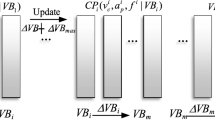Abstract
Tool orientation planning is an essential process in five-axis machining for sculptured parts with complex cavity features. Unlike traditional tool orientation optimization approaches using heuristic algorithms, which demand particularly prolonged time to achieve converged optimal result, this paper presents a novel method for tool orientation optimization based on reinforcement learning algorithm. As input to the method, the rasterized feasible region is first computed via support vector machine based on an active learning fashion that requires highly reduced sampled points. The tool orientation optimization is then converted into a reinforcement learning task, in which a soft actor-critic model is utilized and trained to obtain the optimal policy. According to preliminary testing results, the proposed method is proved to be feasible for tool orientation optimization problem, and effective to produce comparable results more efficiently compared with graph-based optimization method.




















Similar content being viewed by others
References
Chu CH, Huang WN, Li YW (2012) An integrated framework of tool path planning in 5-axis machining of centrifugal impeller with split blades. J Intell Manuf 23:687–698
Xu JT, Zhang DY, Sun YW (2019) Kinematics performance oriented smoothing method to plan tool orientations for 5-axis ball-end CNC machining. Int J Mech Sci 157–158:293–303
Balasubramaniam M, Laxmiprasad P, Sarma S, Shaikh Z (2000) Generating 5-axis NC roughing paths directly from a tessellated representation. Comput Aided Des 32:261–277
Wang N, Tang K (2007) Automatic generation of gouge-free and angular-velocity-compliant five-axis toolpath. Comput Aided Des 39:841–852
Morishige K, Takeuchi Y (1997) 5-axis control rough cutting of an impeller with efficiency and accuracy. In: Proceedings of International Conference on Robotics and Automation. IEEE, pp 1241–1246
Tomas LP (1983) Spatial planning: a configuration space approach. IEEE Transactions on Computers C-32:108–120
Bajaj CL, Kim MS (1989) Generation of configuration space obstacles: the case of moving algebraic curves. Algorithmica 4:157–172
Choi BK, Kim DH, Jerard RB (1997) C-space approach to tool-path generation for die and mould machining. Comput Aided Des 29:657–669
Choi BK (2001) C-space approach to tool-path generation for sculptured surface machining. In: Kimura F (ed) Geometric Modelling. Springer, US, Boston, MA, pp 85–97
Boyse JW (1979) Interference detection among solids and surfaces. Commun ACM 22:3–9
Bobrow JE, Dubowsky S, Gibson JS (1985) Time-optimal control of robotic manipulators along specified paths. Int J Rob Res 4:3–17
Moore M, Wilhelms J (1988) Collision detection and response for computer animation. ACM SIGGRAPH Computer Graphics 22:289–298
Chen Y, Shen LY, Yuan CM (2011) Collision and intersection detection of two ruled surfaces using bracket method. Computer Aided Geometric Design 28:114–126
Jun CS, Cha K, Lee YS (2003) Optimizing tool orientations for 5-axis machining by configuration-space search method. Comput Aided Des 35:549–566
Plakhotnik D, Lauwers B (2014) Graph-based optimization of five-axis machine tool movements by varying tool orientation. Int J Adv Manuf Technol 74:307–318
Mi ZP, Yuan CM, Ma XH, Shen LY (2017) Tool orientation optimization for 5-axis machining with C-space method. Int J Adv Manuf Technol 88:1243–1255
Yuan CM, Mi ZP, Jia XH, Lin FM, Shen LY (2021) Tool orientation optimization and path planning for 5-axis machining. J Syst Sci Complex 34:83–106
Wang YP, Xu JT, Sun YW (2021) Tool orientation adjustment for improving the kinematics performance of 5-axis ball-end machining via CPM method. Robotics and Computer-Integrated Manufacturing 68:102070
Lu YA, Wang CY, Sui JB, Zheng LJ (2018) Smoothing rotary axes movements for ball-end milling based on the gradient-based differential Evolution Method. J Manuf Sci Eng 140
Zou Q, Zhao JB (2013) Iso-parametric tool-path planning for point clouds. Comput Aided Des 45:1459–1468
Suresh K, Yang DCH (1994) Constant scallop-height machining of free-form surfaces. J Ind Eng Int 116:253–259
Balabokhin A, Tarbutton J (2017) Iso-scallop tool path building algorithm “based on tool performance metric” for generalized cutter and arbitrary milling zones in 3-axis CNC milling of free-form triangular meshed surfaces. J Manuf Process 28:565–572
Morishige K, Kase K, Yoshimi Y (1997) Collision-free tool path generation using 2-dimensional C-space for 5-axis control machining. Int J Adv Manuf Technol 13:393–400
Boser BE, Guyon IM, Vapnik VN (1992) A training algorithm for optimal margin classifiers. In: Haussler D (ed) Proceedings of the fifth annual workshop on Computational learning theory - COLT '92. ACM Press, New York, New York, USA, pp 144–152
Pan J, Chitta S, Manocha D (2012) FCL: A general purpose library for collision and proximity queries. In: 2012 IEEE International Conference on Robotics and Automation. IEEE, pp 3859–3866
Finkel RA, Bentley JL (1974) Quad trees a data structure for retrieval on composite keys. Acta Informatica 4:1–9
Sutton RS, Barto AG (1998) Reinforcement learning: an introduction. IEEE Trans Neural Netw 9:1054
Mnih V, Kavukcuoglu K, Silver D, Rusu AA, Veness J, Bellemare MG, Graves A, Riedmiller M, Fidjeland AK, Ostrovski G, Petersen S, Beattie C, Sadik A, Antonoglou I, King H, Kumaran D, Wierstra D, Legg S, Hassabis D (2015) Human-level control through deep reinforcement learning. Nature 518:529–533
Haarnoja T, Zhou A, Abbeel P, Levine S (2018) Soft actor-critic: off-policy maximum entropy deep reinforcement learning with a stochastic actor
Funding
This work was supported by the National Key R&D Programs of China (Grant No. 2020YFA0713704), the National Science Fund for Distinguished Young Scholars (Grant No. 51925505), and the National Natural Science Foundation of China (Grant No. 51805260).
Author information
Authors and Affiliations
Contributions
All authors contributed to the research, writing, and reviewing of the paper.
Corresponding author
Ethics declarations
Ethics approval
Not applicable.
Consent to participate
Not applicable.
Consent for publication
All authors have agreed to authorship, read and approved the manuscript, and given consent for submission and subsequent publication of the manuscript. The authors guarantee that the contribution to the work has not been previously published elsewhere.
Conflict of interest
The authors declare no competing interests.
Additional information
Publisher's Note
Springer Nature remains neutral with regard to jurisdictional claims in published maps and institutional affiliations.
Rights and permissions
About this article
Cite this article
Zhang, Y., Li, Y. & Xu, K. Reinforcement learning–based tool orientation optimization for five-axis machining. Int J Adv Manuf Technol 119, 7311–7326 (2022). https://doi.org/10.1007/s00170-022-08668-5
Received:
Accepted:
Published:
Issue Date:
DOI: https://doi.org/10.1007/s00170-022-08668-5




